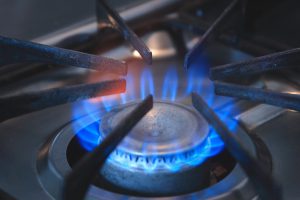Updated November 2024.
Tried any good recipes lately? Despite the comforts of home cooking, there’s something you should know. Kitchen cooking fires are the leading cause of home fires, according to the National Fire Protection Association. By taking a few simple precautions, we can make our time in the kitchen safe as well as rewarding.
Don’t become a fire statistic
As you explore your kitchen gadgets and flex your cooking and baking prowess, remember to make safety a priority.
Statistics show that half (49%) of all fires in the home begin in the kitchen. Kitchen cooking fires are the number one cause of home fires and home-fire injuries.
The stove is the most common source, but other potential fire dangers lurk as people use gas and electric ovens and small kitchen appliances such as microwave ovens, air fryers, instant pots and toaster ovens.
Follow these top three common-sense safety tips to avoid a kitchen cooking fire:
Pay attention. First and foremost, staying safe in the kitchen comes down to simply paying attention. The NFPA reports that unattended cooking is the source of most kitchen fires. Never leave your stovetop cooking unattended, whether you are boiling, frying, broiling or grilling food. Turn off the stove if you need to leave the room. Keep a lid nearby and at the ready, should a pan fire start.
Watch your oven, too, and check your food regularly. Have you ever sat down to dinner and forgotten one of your dishes in the oven, such as rolls? Those rolls probably ended up more like charcoal than bread. Easy solution: use a timer. It’s not hard to get distracted, especially when others are coming and going or if there is background noise such as music or the TV. A timer, whether it’s grandma’s old fashioned wind-up timer or a digital timer on your smart watch or phone, will keep you on track.
Much more dangerous than overbaked rolls are the sauces and grease that drip to the bottom of the oven. Examples include pizza baked directly on the rack (use a drip pan on the shelf underneath!) and a greasy casserole baked in a too-small pan that allows its contents to overflow (use a larger pan!). These drips and overflows may create smoke, and if you allow too much grease or too many food drips and scraps to accumulate on the bottom, it could catch fire.
Clear the clutter. Keep the areas surrounding your stove clear of clutter. You need open space for cooking. Clear away anything that can burn, such as wooden utensils, oven mitts, dish towels, curtains, papers and décor.
Never wear loose clothing when working at the stovetop or oven. Roll up loose sleeves and wear a snugly tied apron if necessary.
Create a safety zone. The NFPA recommends maintaining a three-foot safety perimeter around the stove to keep kids and pets safe. Does your dog like to lay at the foot of the stove to be as close as possible to that frying ground beef? Keep the dog away to prevent a possible burn, not mention a dangerous trip hazard for the cook.
Train children about fire safety in the kitchen. You can find child-focused learning resources on the NFPA website.
What to do in a kitchen fire
Fire-safety experts advise the following in a kitchen cooking fire: For a stovetop grease fire, slide a lid over the pan and turn off the burner to smother the flames. For an oven fire, keep the door closed and turn off the heat. If you can’t stop the fire in these ways, just get out of the house. The NFPA advises to close the door behind you to contain the fire. Call 9-1-1 or the local emergency number once you are outside and away from the fire.
The NFPA offers a video on how to develop a home fire escape plan. The National Safety Council provides information on when and how to use a fire extinguisher and other fire-safety information. Your homeowner policy should cover fire damage in your kitchen, but check your policy and contact your agent if you have any questions.
By simply paying attention, clearing the clutter and creating a safety zone around your stove, you can protect your home and family from the number one cause of fire at home. Stay safe and enjoy your cooking adventures!
by Kris A. Mainellis
